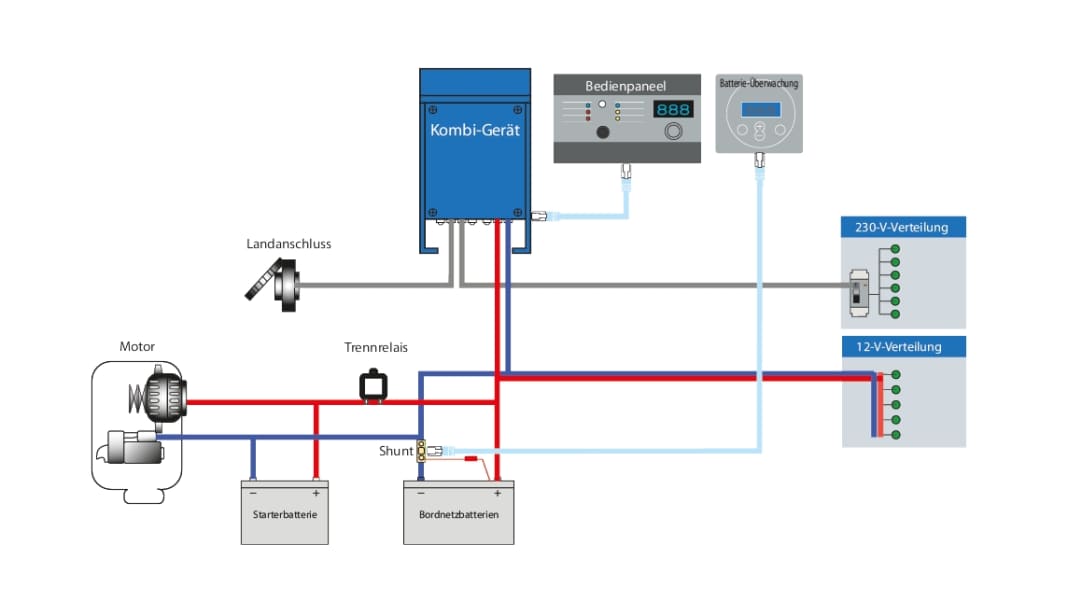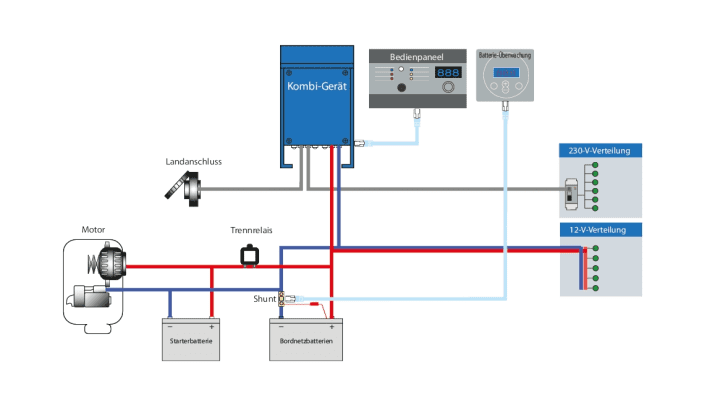
Our 19-year-old Nidelv 26 is being used more and more for long journeys. The increased demands on the technology, particularly in terms of power requirements, are becoming increasingly apparent.
Mobile phones need to be charged, the tablet computer, which is also used for navigation, needs to be supplied with power, a hot water boiler needs to heat the coffee or tea water and on rainy evenings the TV is sometimes on for a long time. All of this should work while travelling and, of course, also in dreamy spots in the countryside.

After all, our Nidelv already has a battery for starting the engine with a capacity of 105 Ah and an on-board power supply battery with 110 Ah. A battery selector switch is used to activate the respective battery for starting or the power consumers on board. If both batteries are to be charged while driving, the switch must be set to position 1+2.
This means that the skipper and crew have to constantly and consciously operate this switch and is therefore not particularly user-friendly. The use of an isolating relay or an isolating diode for this application would be more modern. A shore power socket with a residual current circuit breaker and an automatic charger with IUoU charging characteristics and a maximum current of 12 A were also already installed.
After inspecting and measuring the space available, we planned to replace the on-board power supply battery with three gel batteries, each with a capacity of 130 Ah, i.e. a total capacity of 390 Ah. This would leave around 200 Ah net available for consumption until recharging, assuming that the batteries should only be discharged to a maximum of 50 % each to ensure a long service life. The 105 Ah starter battery, on the other hand, must be retained.
To install and securely hold the batteries in the boat, brackets made from 20 mm aluminium square profiles, suitable connecting elements and 8 mm threaded rods from the DIY store were pre-assembled and installed. Given the weight of the batteries, this seemed more reliable than a standard fastening with webbing. Due to the leak-proof nature of gel batteries, there was no need for an extra battery box.
A commercially available isolating relay was used and installed to separate the starter battery from the consumer battery bank. At the same time, the old battery terminals were replaced and rewired properly. The charging capacity of the new battery charger had to be able to cope with the significantly higher capacity and we wanted to use a DC/AC converter for the 230-volt requirement, which supplies 230-volt alternating current from the 12-volt battery direct current.
To ensure that all appliances can be operated with this current, the inverter must supply a pure sine wave voltage. For reasons of space and convenience, we decided to install a so-called combined device. This combines the charger, converter and changeover switch (shore power/converter/generator) in one device.
In addition, the device allows the shore power takeover to be limited, which is a real gain in convenience, especially at weakly fused shore power sockets. If there is a higher demand for alternating current on board, the converter will automatically supply the additional demand. If there is no shore power, the switchover to the inverter takes place automatically and without interruption.
These appliances are available in different performance levels from various manufacturers. The required size depends on the one hand on personal requirements, and on the other hand on the structural conditions. Of course, a high-performance converter only makes sense if the performance of the batteries is adapted accordingly. And lead batteries in particular are unfortunately still large and heavy.
We decided in favour of a MultiPlus 12/3000/120 from Victron Energy. This device has an inverter output power of 2500 watts and a maximum charging current of 120 A when connected to shore power.
Like the old charger, we mounted the combi under the footrest in front of the passenger seat. Ventilation slots were milled into the platform walls beforehand to ensure good ventilation.
The remote control was connected to the device with an RJ45 UTP cable. As the maintenance-free gel batteries alone require an investment of around €1,000, suitable precautions should be taken to protect the batteries. We therefore decided in favour of a battery monitor to monitor the power storage units.
To do this, the supplied shunt must be installed in the negative cable of the battery bank and a small display unit must be installed in a suitable place in the cockpit. After prior programming, you can then see at any time whether and to what extent power is being drawn or fed in by the charger or generator.
Similar to a fuel gauge, the filling level of the battery bank is also indicated in per cent. After the first few trips and almost 200 hours of boat operation, we can draw a positive balance. We never needed the shore power cable while travelling.
Even after three days of being stationary and using the fridge, lights, kettle, TV, pressurised water pump and computer, our battery bank still had a charge level of over 60%. The generator (alternator) with an output of 60 A running alongside the engine while driving was sufficient for charging.
Material and cost expenditure for the installation described here:
Three gel batteries 130 Ah approx. € 1,041
Victron MultiPlus 12/3000/120 approx. €1,923
Battery monitor with shunt approx. 231 €
Isolating relay kit approx. 150 €
Installation material approx. 400 €

